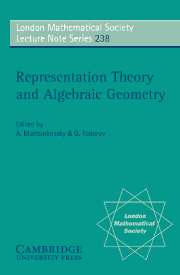Book contents
- Frontmatter
- Contents
- Preface
- Some Problems On Three-Dimensional Graded Domains
- The mathematical influence of Maurice Auslander in Mexico.
- Intertwined With Maurice
- Introduction to Koszul algebras
- Old and recent work with Maurice
- The Development of the Representation Theory of Finite Dimensional Algebras 1968 – 1975
- Algebraic Geometry Over Q
The Development of the Representation Theory of Finite Dimensional Algebras 1968 – 1975
Published online by Cambridge University Press: 06 December 2010
- Frontmatter
- Contents
- Preface
- Some Problems On Three-Dimensional Graded Domains
- The mathematical influence of Maurice Auslander in Mexico.
- Intertwined With Maurice
- Introduction to Koszul algebras
- Old and recent work with Maurice
- The Development of the Representation Theory of Finite Dimensional Algebras 1968 – 1975
- Algebraic Geometry Over Q
Summary
ABSTRACT. The representation theory of finite dimensional algebras has seen a dramatic development in the last 28 years. The foundation of the modern representation theory was laid in the years 1968 – 1975. The aim of this historical survey is to describe the main directions of investigations in these eight years. We will single out eight topics which have been discussed in the years 1968 – 1975 and show their relationship to the present interests. In 1968, there was the solution of the first Brauer-Thrall conjecture. The introduction of the Auslander algebras may be considered as the starting point for a systematic study of module categories. The use of quivers, posets and quadratic forms are now important tools in representation theory. Functorial methods such as Coxeter functors and functorial nitrations of the forgetful functor were introduced during that period in order to deal with specific classification problems. All these methods have turned out to be very fruitful. As we will see, the main emphasis of most investigations was directed towards an understanding of the different representation types: finite, tame and wild, and they were confined to specific classes of algebras. With the proof of the existence of almost split sequences in 1975 Auslander and Reiten presented a result which deals with arbitrary finite dimensional algebras; the notion of an irreducible map and the concept of the corresponding Auslander-Reiten quiver are now basic ingredients of representation theory.
The Setting
Let k be a field, and A a finite dimensional k-algebra (associative, with 1). We consider representations of A, these are algebra homomorphisms from A into the endomorphism algebra of a vector space over k, or, equivalency, (left) A-modules.
- Type
- Chapter
- Information
- Representation Theory and Algebraic Geometry , pp. 89 - 116Publisher: Cambridge University PressPrint publication year: 1997
- 1
- Cited by



